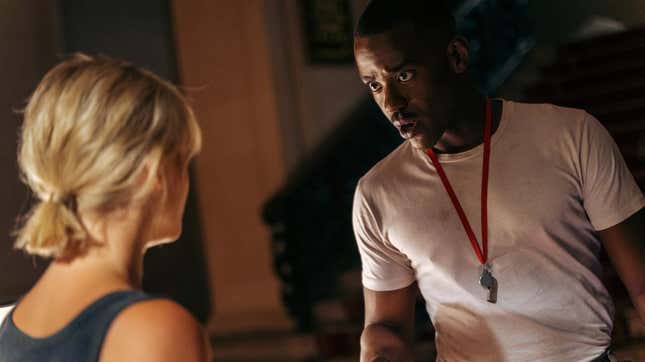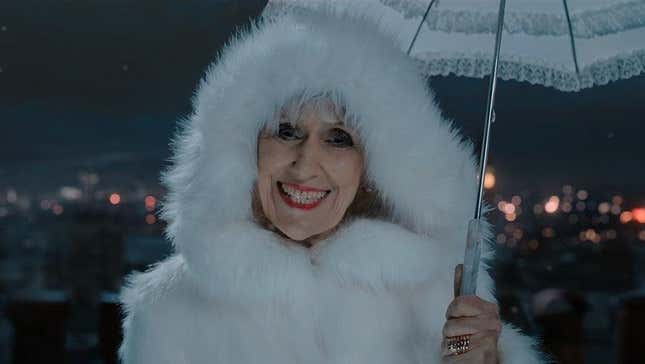Doctor Who is a show about questions more than anything else—more than about time, than about space, than about monsters, than about running up and down corridors to and away from those monsters. It’s in the name, a question so profound that the show has constantly struggled to play with that very essence of its core. So it makes sense that its latest season, something of a relaunch for a new age, brings it all home by weaving through answers to details left throughout its season.
But in doing so, “Empire of Death” posits another question to its audience that it itself struggles to answer: if a mystery’s not meant to be a mystery, then why make it a mystery in the first place?
For the most part, “Empire of Death” is a finale much in a similar manner to many of Russell T Davies’ own prior big-event finales in years past. It’s an episode that leans heavily on emotional climaxes delivered impeccably, in the hope that those highs and heartbreaks, those chills and thrills, will distract you from the fact the episode itself is an ambling, logistical state of perpetual disarray, never quite managing to connect the dots. Arguably, by starting with its biggest, boldest gambit—a gambit that probably should’ve climaxed the already very good ending to last week’s episode—in making Sutekh go all Avengers: Infinity War and kill off 95% of Doctor Who’s supporting cast, and the entirety of Earth, with a skeletonizing sandstorm of doom, much of “Empire” loses its narrative thrust. That’s because the second everyone in the universe except for the Doctor, Ruby, Mel, and Claire from Fleabag (Sian Clifford) is immediately dead, you know that there’s going to be a way back from all this by the end of the next 45 minutes.

Along the way to getting back from all this then, we have, at last, the Doctor and Ruby put in the pressure cooker of having to spend some time with each other. Not in their usual TARDIS, alas—Sutekh and his harbingers have that now, and Sutekh’s apparently just been invisibly clamped to the outside of it for the last 50 years, exposed to the Time Vortex long enough to become an actual god. But instead, hastily thrust into the “Remembered” TARDIS created in UNIT’s time window—itself the narrative crux the Tales of the TARDIS omnibus has been built from—and in there we see the Doctor and Ruby alike forced to confront all the ways their adventures this far have brought them to this point. Alone in the universe, alongside Mel, as stars begin going out one by one, it’s actually a really deft way to get all these moments and ideas woven in from past episodes to make this finale feel like a proper cap to the season. In doing so, it gives the Doctor and Ruby actual time together that—yes, while forced by the literal end of the universe—begins to make the duo feel like the unit the show has tried to tell you they are, rather than show you, for much of the season. These scenes are arguably the moments “Empire” works best, letting Gatwa and Gibson’s electric chemistry shine ever brighter as they hatch a plan to survive Sutekh’s endless chase.
Where that sends them, then, is—after a brief interlude to ask Claire from Fleabag for a spoon, in a scene that, much like the rest of the episode, feels completely out of odds with everything around it but is impeccably acted to emotional catharsis by Gatwa and Clifford—2046, because if the universe is ending, why not get the answer to the big question the Doctor and Ruby have been wanting answered since they met? Again, not much of this makes sense, like how the structure of the UK has managed to persist after Sutekh’s death wave has sandy-fied every living being in existence, but it in begins to layer in the other big element of “Empire of Death”: Ruby learning who her mother really was. Perhaps that the answer so simple a DNA registry search could find it was meant to prime us for what was to come, but considering we have to shift from this moment—via poor Mel being killed by Sutekh and transformed into his harbinger—right to the big climax of the episode, we’re barely given time to sit with just why getting the name of Ruby’s mom was so easy in the first place before we’re thrust into the big climactic finale of the episode. Which… involves dragging Sutekh on a leash through the Time Vortex like he’s a rather literal dog, because he is Death and the Doctor is Life, but because Life is Death and Death is Life, the Doctor has to become Death to bring Life via Sutekh, who is also Death, by sentencing him to death by Time Vortex disintegration?

Anyway, stop asking questions and just appreciate the acting, because everything is fine! The universe is back—maybe even all of it, depending on how far Sutekh’s ctrl+z defeat applies to civilizations lost before Sutekh’s storm, like Gallifrey, or even those destroyed by the Flux in Jodie Whittaker’s tenure. Sutekh is gone, having done very little since his big Thanos sand-snap at the start of the episode. It’s time to ask the right question, after UNIT does their own second check: who is Ruby Sunday’s birth mother, the moment we’ve all been waiting for all season, that’s been teased through magic snow and mysterious carolling, this peculiar woman of such mystery that no one dare see her face, clad in ominous hooded cloaks that Christmas Eve? The woman so mysterious, that before Sutekh himself wiped out the last of the entire universe, even he had to try and find out who she was?
The answer, is no one. Well, it’s Louise Miller (Faye McKeever), a nurse who, 20 years ago at the age of 15, gave birth and fled her abusive family’s home, not even with time to tell her boyfriend about the child, and left her at the church on Ruby Road. And again, the emotional build up around this reveal is wonderful—especially the friction between the Doctor and Ruby, both foundlings, when she has him take her to Louise, now living in Coventry, as the Doctor bitterly notes that she’s had years to look up her daughter and never has, just as he in turn was left abandoned to be found by the Gallifreyans. And, as Russell T Davies himself acknowledged in the episode’s commentary track—in a bizarre clapback to Star Wars: The Rise of Skywalker, of all things—there’s a power in Ruby herself finding out that there is no cosmic secret to all this, but real, messy, incredibly ordinary humanity. She is not Ruby Palpatine, to borrow from Davies’ own apparent distaste for how his new business partners in Disney handled Rey in Star Wars: she’s Ruby Nobody. But again, this is what all of “Empire of Death” has been: compelling emotional work, delivered impeccably by its stars, built off the back of a logical and narrative fallacy.

Treating the ordinary nature of Ruby’s true birth parentage as a perceived gotcha, after a season of playing out layer after layer of importance on the reveal, lessens its impact, because the only reason a “twist” exists in the first place is because Doctor Who has been making this information a grand mystery and telling us as such, rather than it being left for the audience to naturally wonder. So much of Ruby’s development as a character has been built around the mystery of her mother as a crux, to the point that she herself hasn’t really been able to develop until it was resolved. You can’t spend the whole season yelling at the audience that This Is a Mystery, and then, in the end, mock them for having treated it as such. What was the point of making this a mystery if it doesn’t actually impact the characters like one? What was actually worth dragging this out across a whole season, instead of dealing with it in “The Church on Ruby Road” and letting Ruby herself be a character defined beyond this mystery-that’s-not-a-mystery?
In a way, there’s a parallel to all this and the similarly catastrophic approach “Dot and Bubble” took to its last-scene reveal of Finetime’s true nature: if you go back and watch this season of Doctor Who with the context of who Ruby’s mother really is, suddenly so much of what was structurally laid out to get to that reveal doesn’t matter at all. Not because the answer itself is unsatisfying, but because all those moments were laid out to tell you that there was a significance beyond Ruby’s own character arc to this reveal that were ultimately nothing but red herrings. The structural mystery of “Dot and Bubble” was deliberately designed so that you’d never guess that the real twist of it all was white supremacy. The structural mystery of “Empire of Death,” and of the season at large, is likewise deliberately designed so you’d never guess its actual outcome. It’s just that this time it’s Rey Palpatine fix-it fic, of all things!

But again, all that doesn’t matter now. “Empire of Death” sees Ruby bid farewell to her time in the TARDIS, choosing to explore her life with her family now this not-so-grand mystery has been solved (even though we, the audience, already know she’s back in some capacity next season), only for Doctor Who to already be setting up its next one, as we cut from the Sunday-Miller clan rejoicing in togetherness to Mrs. Flood on the roof, decked out in a fancy winter coat and umbrella as she spouts promises of terrors to come for the Doctor. The problem is, why should we care about who Mrs. Flood is at this moment? We’ve just had Doctor Who build up one mystery, only to tell us it wasn’t one at all. Will it be the case with her? Will it actually matter? It’s emblematic of a season that, at large, has struggled to figure out what it wants to say in this new era of Doctor Who. If you can’t trust Doctor Who to answer a question, then what can you trust it to do?
Want more io9 news? Check out when to expect the latest Marvel, Star Wars, and Star Trek releases, what’s next for the DC Universe on film and TV, and everything you need to know about the future of Doctor Who.
Trending Products

Cooler Master MasterBox Q300L Micro-ATX Tower with Magnetic Design Dust Filter, Transparent Acrylic Side Panel…

ASUS TUF Gaming GT301 ZAKU II Edition ATX mid-Tower Compact case with Tempered Glass Side Panel, Honeycomb Front Panel…

ASUS TUF Gaming GT501 Mid-Tower Computer Case for up to EATX Motherboards with USB 3.0 Front Panel Cases GT501/GRY/WITH…

be quiet! Pure Base 500DX Black, Mid Tower ATX case, ARGB, 3 pre-installed Pure Wings 2, BGW37, tempered glass window

ASUS ROG Strix Helios GX601 White Edition RGB Mid-Tower Computer Case for ATX/EATX Motherboards with tempered glass…










